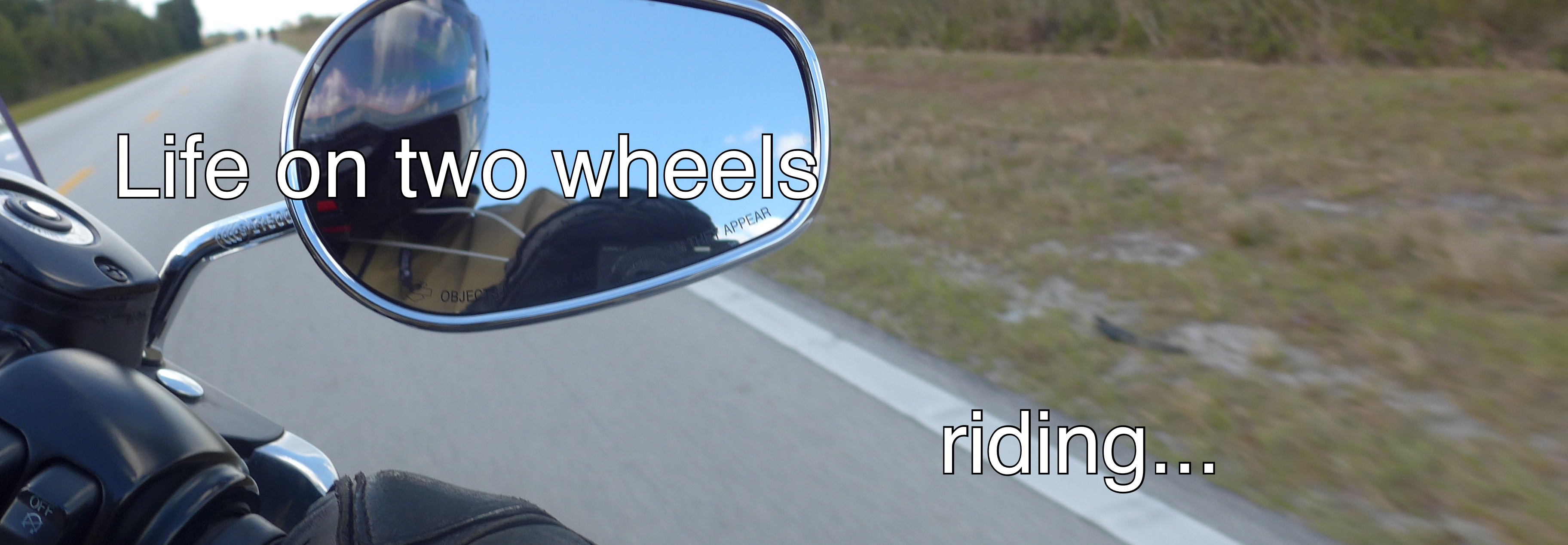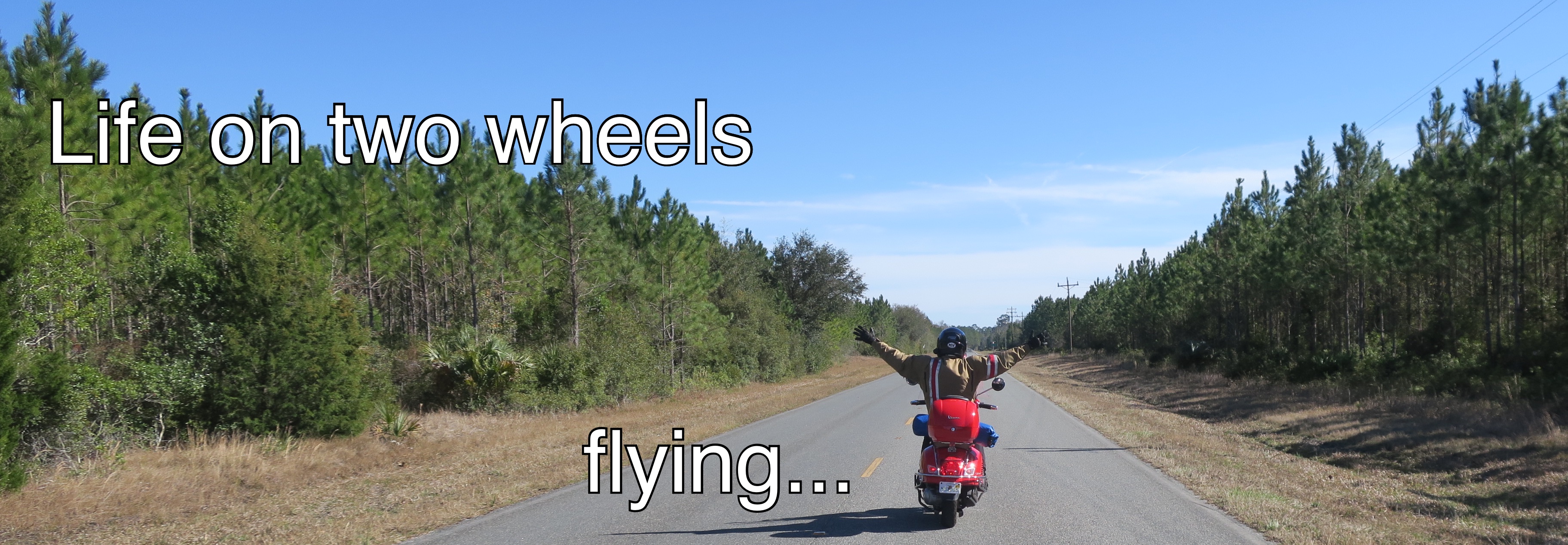The city in the title backdrop is Montreal. I took the three pictures I used to make the composite view of the city on a flight home from Victoria in the fall of 2008. The city is seen looking to the south.
(Ed.: this journal was redesigned in late 2015 and the original header was changed. Here is what it used to look like:
That should provide the needed context.)
To begin this blog, a little context is in order.
I vividly remember my first bike. It was to be the present for my seventh birthday. A candy apple red Raleigh 24" frame, coaster brake bike. I dreamt about that bike. I imagined I could ride it. I day-dreamed about what it would be like to get it for what seemed like eternal winter weeks and months.
When I finally got the bike in the spring, it was everything I had hoped for. It spent the first night in my room, on its center stand, at the foot of my bed. In the darkened room, with my eyes closed, unable to sleep, I could smell its presence. A whiff of that wonderful smell that you get when you walk into a bicycle store.
I found out the next day that actually learning to ride that bike was going to be incredibly scary, difficult, and ultimately in those first few days, painful.
Like most kids I persevered and never looked back. Growing up, my bicycle was the key to freedom. Endless summer days and evenings, riding with my friends, every day a fresh adventure, more riding skills learned.
By junior college, I was riding a second-hand 10-speed bike. I was easily doing 30 or 40 miles a day, between home on Montreal's north shore, to my summer job near the airport, and then east to Ville St-Laurent for summer classes.
In university I managed to convince my parents and my grandmother to buy me a moped for my birthday. All I could afford was a Solex. It was basically a more or less sturdy bicycle with a 49cc engine driving a kind of abrasive roller that rested on the front tire. In dry weather it could easily do 20 miles an hour. In the rain, the water lubricated the roller causing slippage, and you were lucky to do 15... 10 if there was a head wind. That could be misery. Still, I loved that bike and the freedom it brought.
Read on, there's a picture of a Solex below.
With each each new bike, my range increased. I thought nothing of jumping on the Solex at my parents' house (then located on the western slope of Mount Royal) to visit my friends who lived 25 miles away in Ste-Rose.
Eventually I graduated to a family of my own, kids, cars, hockey and soccer practices, dog walking, and life on two wheels just became a thing of the past.
In the mid eightys I left my law firm to work in-house for a large Canadian public company. The firm’s managing partner bought me a really good Norco touring bike as a parting gift.
It was by far the best bike I have owned.
I began to re-discover the pleasures of cycling. As my sons, and later my daughter, learned to ride as well, we would take longer and longer rides. Eventually, the kids grew up, and, as I had done, moved on to cars. Somewhere along the way I was lucky to acquire a nice shiny red (my wife was quick to point out it was "mid-life crisis red") Miata roadster, so I wasn’t exactly pining away and missing life on two wheels.
2008 was a turning point in my life on two wheels.
My wife and I got to take two weeks’ vacation in Paris and Barcelona. Both those cities were firsts for us, and we absolutely loved each of them.
What struck me most was how people in Europe live on two wheels. It didn’t take long for that impression to hit home. In the taxi on the way to our rented condo, as we drove along the expressway towards Paris, there were actually five lanes of traffic on the three lane expressway: motorcycles and scooters were riding the white lines and traveling somewhat faster than the cars and trucks. 110km an hour in rush hour traffic on the lane dividers on scooters… all kinds of scooters, Vespa GTs, Burgmans, MP3s, and three-wheeled BMW scooters complete with 4-point seatbelts, stereos and windshield wipers.
I have to say it made quite an impression. Including the person seen here commuting on a Solex.
have to say it made quite an impression. Including the person seen here commuting on a Solex.
After two weeks of seeing all those folks living care-free on two wheels, I began to think I could do the same in Montreal.
I first rented a scooter in the fall of 2008 during a conference in Victoria B.C. I spent a wonderful afternoon riding as far as I could up the coast of Vancouver Island. What a blast.
Last fall, I rented a Vespa LX50 for a couple of days and tested a commuting route from my home on the western tip of the island to my office in the downtown core. It was October 31st and it rained for both the trip home and the trip back to the Vespa dealer. Without real rain gear, I was wetter than I have ever been, and cold too… but in spite of less than ideal conditions, I was firmly hooked by the Vespa bug.
Three weeks ago I took delivery of a second-hand, lovingly cared-for, dragon-red, Vespa LX150 with a Vespa top case. What a dream.
I haven’t begun to commute quite yet since there are some minor issues to deal with, such as installing a turn indicator buzzer (since I have discovered to my dismay that, try as I may, I remain prone to forgetting to cancel the indicators; a nice, loud, Italian air horn (a Stebel Compact Nautilus, to be precise), because I don’t  want to be going “meep-meep” when some fool is bent on threatening my life; and lastly, the scooter didn’t come with its master key, so my only key is off on its own adventure getting cloned.
want to be going “meep-meep” when some fool is bent on threatening my life; and lastly, the scooter didn’t come with its master key, so my only key is off on its own adventure getting cloned.
April 1, 2010 (I know, April Fools Day, but I’m not a prankster, this is for real) will mark the beginning of my scoot commute.
I learned a ton of stuff from reading scooter blogs and following the posts at Modern Vespa since last fall, and I figure that I owe it to others to share my experience as well.
This blog will not just be about my Vespa. Montreal inaugurated North America’s first public bike system last summer, and I am proud to say that I was one of the very first subscribers. I got a special black smart card key to prove it. From the first day the service began in May until the bikes were taken off the streets for the winter at the end of November, I racked up more than 600 kilometers on Bixi bikes. The Bixis are the best gift I have received from the Cìty of Montreal since Expo 67. This summer I'll continue to Bixi on my lunch hour, getting down to Old Montreal, and up to the Plateau, or over to the Atwater Market for lunch.
Future posts will not likely be anywhere near this long. I just figured I needed to introduce myself properly before getting on with it.
 Stewart Hall is a stately mansion designed by Robert Finlay, a Scottish architect, on a commission from General Charles Wesley McLean. Finlay also designed many of Montreal's great mansions for the city's elite, that are, for the most part, situated on the slopes of Mount Royal, and particularly in the downtown area north of Sherbrooke street known as the Golden Mile.
Stewart Hall is a stately mansion designed by Robert Finlay, a Scottish architect, on a commission from General Charles Wesley McLean. Finlay also designed many of Montreal's great mansions for the city's elite, that are, for the most part, situated on the slopes of Mount Royal, and particularly in the downtown area north of Sherbrooke street known as the Golden Mile. Stewart Hall serves as the City of Pointe Claire's cultural centre.
Stewart Hall serves as the City of Pointe Claire's cultural centre. On the technical side of things, I'm wondering about whether a windscreen would be a good addition for the Vespa. There's the choice of low, medium or high windshields. I've yet to read anything convincing on the Modern Vespa forum one way or the other, other than some people swear by them.
On the technical side of things, I'm wondering about whether a windscreen would be a good addition for the Vespa. There's the choice of low, medium or high windshields. I've yet to read anything convincing on the Modern Vespa forum one way or the other, other than some people swear by them.






























